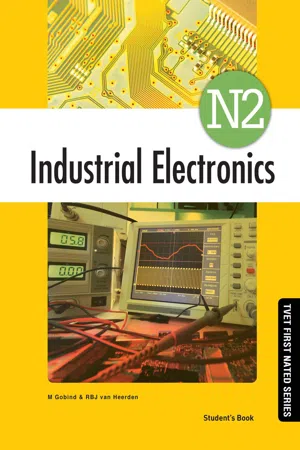
- English
- PDF
- Available on iOS & Android
eBook - PDF
About this book
Plenty of relevant worked examples and activities so students engage actively with the content. Numerous clear diagrams to aid understanding.
Frequently asked questions
Yes, you can cancel anytime from the Subscription tab in your account settings on the Perlego website. Your subscription will stay active until the end of your current billing period. Learn how to cancel your subscription.
No, books cannot be downloaded as external files, such as PDFs, for use outside of Perlego. However, you can download books within the Perlego app for offline reading on mobile or tablet. Learn more here.
Perlego offers two plans: Essential and Complete
- Essential is ideal for learners and professionals who enjoy exploring a wide range of subjects. Access the Essential Library with 800,000+ trusted titles and best-sellers across business, personal growth, and the humanities. Includes unlimited reading time and Standard Read Aloud voice.
- Complete: Perfect for advanced learners and researchers needing full, unrestricted access. Unlock 1.4M+ books across hundreds of subjects, including academic and specialized titles. The Complete Plan also includes advanced features like Premium Read Aloud and Research Assistant.
We are an online textbook subscription service, where you can get access to an entire online library for less than the price of a single book per month. With over 1 million books across 1000+ topics, we’ve got you covered! Learn more here.
Look out for the read-aloud symbol on your next book to see if you can listen to it. The read-aloud tool reads text aloud for you, highlighting the text as it is being read. You can pause it, speed it up and slow it down. Learn more here.
Yes! You can use the Perlego app on both iOS or Android devices to read anytime, anywhere — even offline. Perfect for commutes or when you’re on the go.
Please note we cannot support devices running on iOS 13 and Android 7 or earlier. Learn more about using the app.
Please note we cannot support devices running on iOS 13 and Android 7 or earlier. Learn more about using the app.
Yes, you can access Industrial Electronics N2 Student's Book by M Gobind RBJ van Heerden in PDF and/or ePUB format, as well as other popular books in Technology & Engineering & Engineering General. We have over one million books available in our catalogue for you to explore.
Information
Table of contents
- Front Cover
- Title Page
- Imprint Page
- Acknowledgements
- Contents
- Terminology, units and symbols
- MODULE 1: Atomic theory
- Unit 1.1: The basics of atomic theory
- Unit 1.2: Conductors, insulators and semiconductors
- Unit 1.3: Energy levels, free electrons and covalent bonds
- Summary of Module 1
- Summative assessment of Module 1
- MODULE 2: Direct current theory
- Unit 2.1: Current, resistance, voltage and resistivity
- Unit 2.2: Laws that relate to current, voltage and resistance
- Unit 2.3: Resistors in series
- Unit 2.4: Resistors in parallel
- Unit 2.5: Resistors in series-parallel combinations
- Summary of Module 2
- Summative assessment of Module 2
- MODULE 3: Alternating current theory
- Unit 3.1: Basics of AC theory
- Unit 3.2: The sine wave
- Unit 3.3: The mid-ordinate rule
- Unit 3.4: Phase relationships
- Unit 3.5: Single-phase AC circuits
- Summary of Module 3
- Summative assessment of Module 3
- MODULE 4: Semi conductor physics
- Unit 4.1: Semiconductor materials
- Unit 4.2: N-type and P-type material
- Unit 4.3: Electron flow and hole flow in semiconductor materials
- Summary of Module 4
- Summative assessment of Module 4
- MODULE 5: Semiconductor diodes 5
- Unit 5.1: The semiconductor PN-junction
- Unit 5.2: Biasing
- Unit 5.3: The semiconductor diode
- Unit 5.4: Types of diodes
- Unit 5.5: Rectification and filter circuits
- Summary of Module 5
- Summative assessment of Module 5
- MODULE 6: Semiconductor transistors
- Unit 6.1: PNP and NPN transistors
- Unit 6.2: Transistor applications
- Summary of Module 6
- Summative assessment of Module 6
- MODULE 7: Measuring instruments
- Unit 7.1: Analogue meters
- Unit 7.2: The voltmeter
- Unit 7.3: The ammeter
- Unit 7.4: The ohmmeter
- Unit 7.5: Multimeter principles
- Unit 7.6: Precautions and care
- Summary of Module 7
- Summative assessment of Module 7
- MODULE 8: Transducers
- Unit 8.1: Light-dependent resistor (LDR)
- Unit 8.2: The bimetallic strip
- Unit 8.3: The thermocouple
- Unit 8.4: Thermistors
- Summary of Module 8
- Summative assessment of Module 8
- MODULE 9: Synchro systems
- Unit 9.1: The synchro system
- Unit 9.2: How the synchro system works (transmitterand receiver)
- Unit 9.3: Synchro phase displacement
- Summary of Module 9
- Summative assessment of Module 9
- MODULE 10: The decibel
- Unit 10.1: Calculating gain or loss
- Unit 10.2: Voltage and current gain or loss
- Summary of Module 10
- Summative assessment of Module 10
- Short answers
- Glossary
- Back Cover